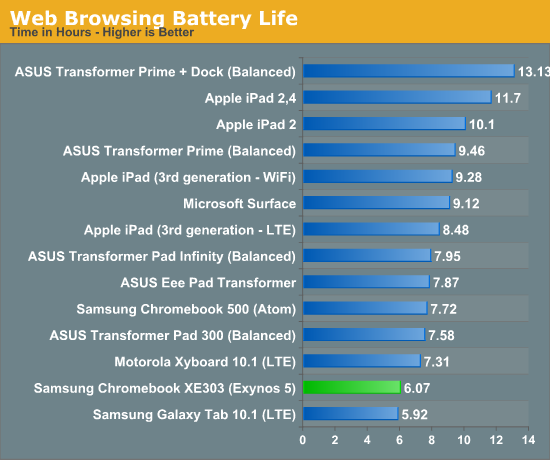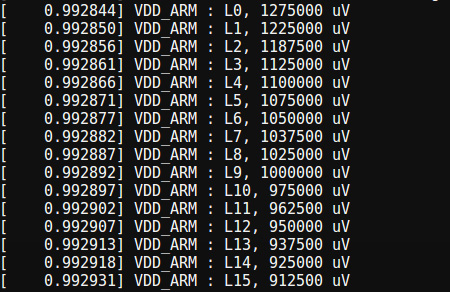Samsung Chromebook (XE303) Review: Testing ARM's Cortex A15
by Anand Lal Shimpi on October 31, 2012 9:00 AM ESTBattery Life & Power Analysis
The final unknown in all of this is power consumption. ARM's Cortex A15 isn't really supposed to be a sipper of power, and when placed in a notebook I don't know that there's a lot we can conclude about how it stacks up to Atom either. Some high level power consumption data would normally help but these two platforms are fairly different:
| Samsung Chromebook Power Consumption Comparison | ||||||
| Display @ 200 nits | Idle | Kraken (Avg) | Kraken (Peak) | |||
| Samsung Chromebook 500 (Atom N570) | 11.53W | 14.4W | 15.2W | |||
| Samsung Chromebook 303 (Exynos 5 Dual) | 6.33W | 10.5W | 11.3W | |||
The new Chromebook consumes considerably less power at idle than its predecessor. The smaller display, simplified motherboard and truly integrated SoC platform are likely all to thank for this. The significant reduction in power also helps explain the big reduction in battery capacity as well.
Under load, the two platforms do see differing levels of additional power consumption. The new Exynos 5 based Chromebook sees a dramatic increase in power consumption under load, hitting 10.5W (a 66% increase over idle) while running Mozilla's Kraken benchmark. The Atom N570 based Chromebook increases power consumption as well, but just not by as significant a degree: ~25%. This actually helps illustrate exactly why Atom wasn't phone worthy in its earlier incarnations. Contrary to popular belief, it wasn't actually peak power consumption that was the problem (a move to 32nm can easily eat into these numbers). The total platform power consumption, particularly at idle, was Atom's real problem in the early days. It also turns out that this is much of what keeps Intel's Core processors from moving into ultra mobile form factors, something that Haswell is supposed to address.
Given that we're dealing with somewhat different panels here, I wanted to see what power consumption looked like if we removed the panels from the equations. I re-ran all of the power data with the display turned off:
| Samsung Chromebook Power Consumption Comparison | ||||||
| Display Off | Idle | Kraken (Avg) | Kraken (Peak) | |||
| Samsung Chromebook 500 (Atom N570) | 8.82W | 11.4W | 12.4W | |||
| Samsung Chromebook 303 (Exynos 5 Dual) | 4.07W | 8.32W | 9.27W | |||
The old Atom based Chromebook uses more than twice the idle power of the new version - it's no wonder Google was able to get away with a battery half the size. Once again however we see a much larger increase in power consumption once the Cortex A15 is under heavy load. Active power consumption more than doubles on the new Chromebook, while we see around a 30% increase on the Atom based system. I do wonder what will have to be done to get the Exynos 5 Dual into a smartphone as an increase of ~4W under load just won't cut it in a phone. The Atom platform shows a 2.6W increase in power under load, which sounds about right for a high clocked 45nm part.

Despite the more power efficient platform, the reduction in battery capacity puts the new Chromebook well below the Atom model in battery life. Our wireless web browsing test put the new Chromebook at just over 6 hours of continuous use on a single charge. For a notebook that's not too bad, but compared to modern tablets it's not good.

The performance gains over Atom (and by extension, the ARM Cortex A9) do give us some indication as to what could be done to get Exynos 5 into a smartphone. By dropping clocks much lower than 1.7GHz Samsung would be able to maintain a performance advantage in a very power constrained device and hopefully keep power in check. The photo above features a list of all of the voltage levels supported by Samsung's Exynos 5 Dual as implemented in the new Chromebook.










149 Comments
View All Comments
jeffkro - Wednesday, October 31, 2012 - link
Krait, might loose out to this A15 in all out performance but it is pretty great for battery life especially on LTE phones.Krysto - Thursday, November 1, 2012 - link
LTE has nothing to do with the chip. Those quad core S4 Pro's aren't even integrated with LTE yet. Latest LTE efficiency comes from the fact that it's made at 28nm, not at 45nm - the LTE chip itself that is.tipoo - Wednesday, October 31, 2012 - link
Impressive that the A15 beats Atom across the board, and draws significantly less power doing that. Complete leapfrog.eddman - Wednesday, October 31, 2012 - link
Not a valid comparison IMO when it comes to power consumption. That's an old 45nm Atom. Clover trail will do much better, thanks to the 32nm process and its new S0ix power states.tipoo - Wednesday, October 31, 2012 - link
Fair enough, but the performance per clock won't go up significantly until Silvermont.silverblue - Wednesday, October 31, 2012 - link
Still, the current Atom and Brazos are only mild updates (if that). The E2-1800 in HP's dm1 gets 547 in Sunspider, so clock-for-clock, Brazos 2.0 is ahead on this single test. However, the power consumption must be signicantly more. Still, slightly different markets.I would very much like to see the next Atom plus AMD's Jaguar; reduced power and better performance could make for a decent A15 competitor.
lmcd - Thursday, November 1, 2012 - link
Supposedly these were the leaky chips, so we could have a similar story in Samsung's favor.Krysto - Thursday, November 1, 2012 - link
Brazos has a much higher TDP though. Was it 10W for CPU and another 8 for the GPU? It's crazy.Krysto - Thursday, November 1, 2012 - link
Clover Trail is not a mobile chip. Only Medfield is, and they don't even have a dual core version yet. You will never see Clover Trail in smartphones (yet you will see Cortex A15), and the only reason you will see them in Windows 8 tablets is because Medfield would be too slow with Windows 8, and Clover Trail is more powerful, but also uses much more power, and they are willing to compromise on that, while lying through their teeth that it will get 8-9h of battery life. It will get nowhere close to that.wsw1982 - Thursday, November 1, 2012 - link
the clover trail is about 3.5+ w tdp according to some review. the samsung a15 is a 6+w soc. what make you think a 3.5 w soc cannot go to mobile, but a 6+w soc can?